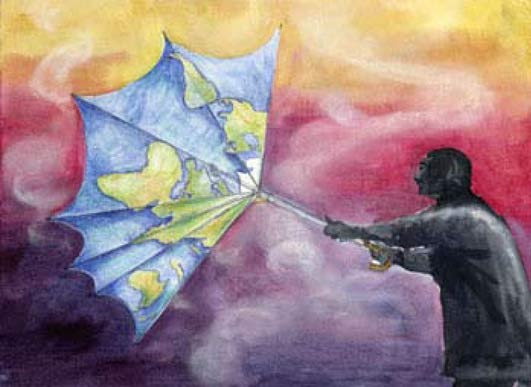Clear and getting hotter this mid-day Saturday here in California’s Central Valley — we’re in the high 80s right now on our way to 102 later this afternoon. A ‘cool‘ space is forecast to start tomorrow and last maybe a week or so with high temperatures expected in the mid-90s (WTF! 90 degrees considered ‘cool‘).
We live tomorrow today and that ain’t good.
Instead of politics as usual, let’s engage in some environmental fisticuffs with the above-mentioned heat — from The New York Times last Thursday:
This year is on track to be the warmest on record after the previous high set in 2023, according to the European Union’s Copernicus Climate Change Service.
Two days in July were the hottest days on record in a data set that extends back to 1940. The month was the second-warmest July on record, ending the more than yearlong streak of global monthly temperature records.
July was only 0.04 degrees Celsius lower than the previous high set in July 2023. These temperatures led to heat waves that impacted millions of people in the United States.
Greenhouse gas emissions, largely from burning fossil fuels, continue heating up the planet. Increasing temperatures are tied to more extreme weather events, including heat waves, hurricanes and excessive rainfall.
However, here in California, July was actually the hottest month ever:
Well, it's official: California just experienced its warmest July on record. This is now the third time in the past 10 years California has broken its previous July record–and this time shattered previous record by a genuinely startling nearly 2°F (!) margin. #CAwx #CAfire [1/3] pic.twitter.com/p9RquJDP5I
— Dr. Daniel Swain (@Weather_West) August 9, 2024
Details via San Jose’s The Mercury News this morning:
July’s searing temperatures made it California’s hottest month on record, according to national weather data. The average temperature statewide was 81.7°, almost two degrees warmer than the previous record set in 2021.
“That is a huge margin,” said Daniel Swain, a climate scientist with UCLA. “Not only did we break the previous record, but we essentially shattered it.”
Heat waves lasted through most of July in much of the state, with daily temperature highs soaring over the triple digits. And, crucially, temperatures stayed warm overnight, increasing the average temperature for the month.
Yet “people’s experience depending on where they lived in California was very different,” Swain said, with inland cities experiencing the worst warming.
Sacramento and Fresno each had their hottest July numbers on record at 81.1° and 90.0°, respectively. Alameda, Contra Costa and Santa Clara counties each deviated more than 7 degrees above historical averages with July average temperatures of 76.7°, 78.3° and 76.5°.
Coastal cities experienced less severe increases. San Francisco’s July averaged 66.6°, about 3 degrees above its historical mean, but still the hottest it has ever recorded.
The National Oceanic and Atmospheric Administration has recorded monthly temperatures for more than 100 years, and California has broken all-time monthly heat records three times in the past decade. A blistering July in 2018 averaged 79.6°F in California, which was knocked out by a 79.8°F average in 2021. The previous record of 79.5°F was set in 1931.
While July’s temperature spike was “remarkable,” Swain said, it wasn’t surprising.
“It is, unfortunately, very consistent with expectations that we’re going to see hotter and hotter summers,” Swain said.
California, alongside the rest of the world, is “stair-stepping upward” to a warmer climate, Swain said. Some years will be relatively warmer or cooler than others, so it’s possible next summer’s heat waves could be less severe. But on the state’s current climate trajectory toward warmer summers, a July as hot as this one will become “ordinary, if not on the cool side of things” in the near future, Swain said.
Further from the Guardian, also this morning:
Death Valley, the hottest place on Earth, recorded its hottest month ever in July, according to the National Park Service (NPS). In Nevada, Las Vegas reached 120F on 7 July, its hottest day in history, and set a record for number of days over 115F.
The impacts of extreme heat are being felt across the US and the world as the climate crisis drives increasingly severe and dangerous weather conditions. Last month about one-third of the US population was under warnings for record heat. The Earth saw its hottest day in recorded history on 22 July, breaking a record set just one day earlier.
[…]
Heatwaves are increasing in intensity and frequency, as well as duration and range, and are the weather events most directly impacted by the climate crisis, Dr Alexander Gershunov, a research meteorologist with the Scripps Institution of Oceanography, told the Guardian last month. He described heatwaves as “the weather extremes that are impacted by the steroids of climate change”.
“The trend is toward more frequent, more extreme, longer-lasting heatwaves all over the world,” he said. “California is certainly no exception.”
Of course, this isn’t due to us being California, Left-Coast freak nuts, it’s just we happen to be in this location — earth. The world is in a grip of fear: ‘So far, the Earth has only crossed that threshold for a single year. However, it is still extremely concerning. We study weather patterns involving heat. The world appears to be on track to cross the 30-year average threshold of 1.5 C within 10 years.‘
Or as most likely, much, much sooner.
And then it’s all black and white even with color:
Despite the heat, yet here we are once again…
 (Illustration out front from the UN’s International Children’s Painting Competition, and found here.)
(Illustration out front from the UN’s International Children’s Painting Competition, and found here.)